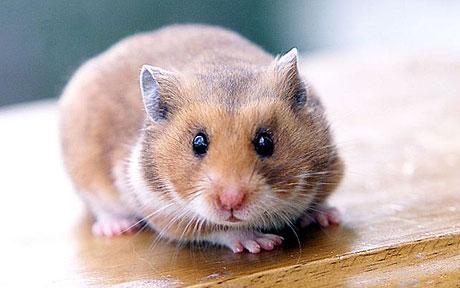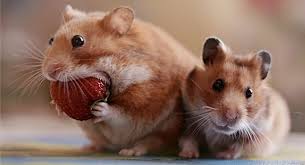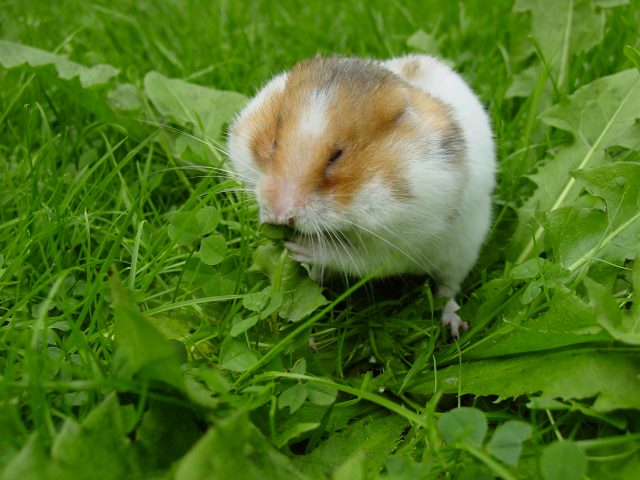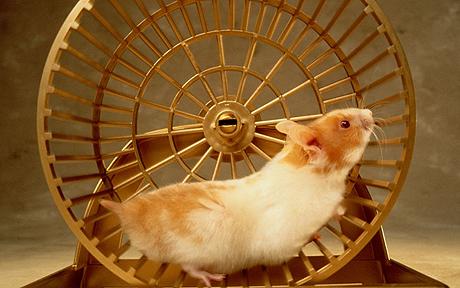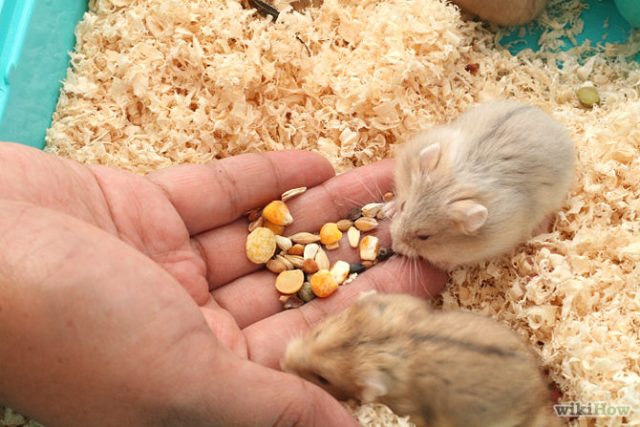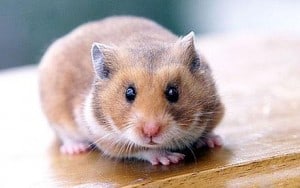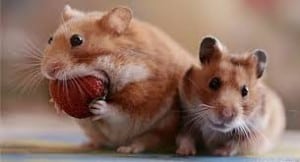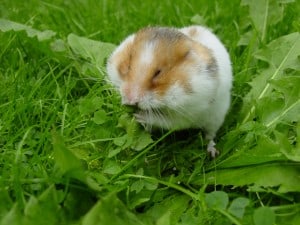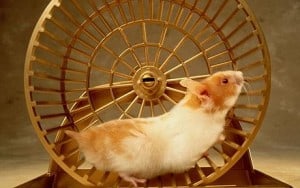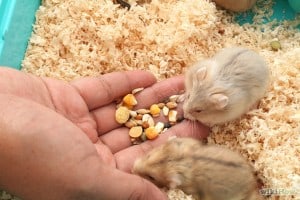Type the name of the breed you're looking for below
[wpdreams_ajaxsearchlite] Don't see the breed your're looking for? Click here and let us know!Hamster
| Origin | Hamsters are rodents belonging to the subfamily Cricetinae. The subfamily contains about 25 species, classified in six or seven genera. They have become established as popular small house pets and partly because they are easy to breed in captivity, hamsters are often used as laboratory animals. In the wild, hamsters are crepuscular and remain underground during the day to avoid being caught by predators. They feed primarily on seeds, fruits, and vegetation, and will occasionally eat burrowing insects. They have elongated cheek pouches extending to their shoulders in which they carry food back to their burrows. The name "hamster" is a loanword from the German, which itself derives from earlier Old High German hamustro. It is possibly related to Old Russian choměstrǔ, which is either a blend of the root of Russian khomiak "hamster" and a Baltic word (cf. Lithuanian staras "hamster") or of Persian origin (cf. Av hamaēstar "oppressor"). |
| Natural Habitat | The golden hamster or Syrian hamster (Mesocricetus auratus), is a member of the subfamily Cricetinae, the hamsters. In the wild, they are now considered vulnerable. Their natural geographical range is limited to the north of Syria and the south of Turkey, in arid habitats. Their numbers have been declining due to loss of habitat caused by agriculture and deliberate destruction by humans. However, captive breeding programs are well established, and captive-bred golden hamsters are popularly kept as pets and used as scientific research animals throughout the world. |
| Wild Species | The best-known species of hamster is the golden or Syrian hamster (Mesocricetus auratus), which is the type most commonly kept as pets. It is also sometimes called a "fancy" hamster. The pet trade and fanciers have given names to several color variations, including "honey bear", "panda bear", "black bear", "European black bear", "polar bear", "teddy bear", and "Dalmatian". Several variations, including long-haired varieties, grow hair several centimeters long and often require special care. British zoologist Leonard Goodwin claimed most hamsters kept in the United Kingdom were descended from the colony he introduced for medical research purposes during the Second World War. Other hamsters kept as pets are the various species of "dwarf hamster". Campbell's dwarf hamster (Phodopus campbelli) is the most common—they are also sometimes called "Russian dwarfs"; however, many hamsters are from Russia, so this ambiguous name does not distinguish them from other species appropriately. The coat of the Djungarian or winter-white Russian dwarf hamster (Phodopus sungorus) turns almost white during winter (when the hours of daylight decrease). The Roborovski hamster (Phodopus roborovskii) is extremely small and fast, making it difficult to keep as a pet. The Chinese hamster (Cricetulus griseus), although not technically a true "dwarf hamster", is the only hamster with a prehensile tail (about 4 cm long)—most hamsters have very short, nonprehensile tails. Hamsters are typically stout-bodied, with tails shorter than body length, and have small, furry ears, short, stocky legs, and wide feet. They have thick, silky fur, which can be long or short, coloured black, grey, honey, white, brown, yellow, red, or a mix, depending on the species. Two species of hamster belonging to the genus Phodopus, Campbell's dwarf hamster (P. campbelli) and the Djungarian hamster (P. sungorus), and two of the genus Cricetulus, the Chinese striped hamster (C. barabensis) and the Chinese hamster (C. griseus) have a dark stripe down their heads to their tails. The species of genus Phodopus are the smallest, with bodies 5.5 to 10.5 cm (2.2 to 4.1 in) long; the largest is the European hamster (Cricetus cricetus), measuring up to 34 cm (13.4 in) long, not including a short tail of up to 6 cm (2.4 in). The Angora hamster, also known as the long-haired or teddy bear hamster, which is a type of the golden hamster is the second-largest hamster breed, measuring up to 18 cm (7.1 in) long. The hamster tail can be difficult to see, as it is usually not very long (about 1/6 the length of the body), with the exception of the Chinese dwarf hamster, which has a tail the same length as the body. One rodent characteristic that can be highly visible in hamsters is their sharp incisors; they have an upper pair and lower pair which grow continuously throughout life, so must be regularly worn down. Hamsters are very flexible, but their bones are somewhat fragile. They are extremely susceptible to rapid temperature changes and drafts, as well as extreme heat or cold. |
| History with Humans | Although the Syrian hamster or golden hamster (Mesocricetus auratus) was first described scientifically by George Robert Waterhouse in 1839, researchers were not able to successfully breed and domesticate hamsters until 1939. The entire laboratory and pet populations of Syrian hamsters appear to be descendants of a single brother-sister pairing. These littermates were captured and imported in 1930 from Aleppo [Syria] by Israel Aharoni, a zoologist of the University of Jerusalem. In Jerusalem, the hamsters bred very successfully. Years later, animals of this original breeding colony were exported to the USA, where Syrian hamsters became one of the most popular pets and laboratory animals. Comparative studies of domestic and wild Syrian hamsters have shown reduced genetic variability in the domestic strain. However, the differences in behavioral, chronobiological, morphometrical, hematological, and biochemical parameters are relatively small and fall into the expected range of interstrain variations in other laboratory animals. |
| As Pets | Many breeders also show their hamsters, so breed towards producing a good, healthy, show hamster with a view to keeping one or two themselves, so quality and temperament are of vital importance when planning the breeding. |
| Colour Variations | Campbell Russian Dwarf hamsters: The Campbell Russian Dwarf hamster is known as a very sociable hamster and unlike syrian hamster, Campbell hamsters can be kept in colonies and can live together happily. You will often see them all curled up together in their bedding, quite content with one another. The Campbell when fully grown can reach up to around 4 inches and colours can vary depending on the breeding. Some are a grayish brown (wild colour), others a sandy cinnamon colour with a white belly or dull brownish orange with a white belly, albino with red eyes, a bluish gray and finally Campbells can be black all over. Campbells also have different types of marking on their fur, these are: mottled (irregular white patches), ruby-eyed mottled (appears as irregular black patches) and platinum (white furs mingling amongst the hamsters fur/coat). In the wild, Campell hamsters have been known to dig burrows up to 3 feet in depth and then line them with wool gathered from surrounding herd plains. As such, if you can provide your hamster with a nice deep cage filled with wood shavings, you will be providing your hamster(s) with a wonderful opportunity to dig and burrow. Best of all, it's great fun watching them as they dig away! Roborovski hamsters: Roborovski or "robo" hamsters as they are commonly known are the smallest of all hamsters and as definitely the fastest! Because of this, robo's are often suited to older owners (teenagers up). Young children will have difficulties holding them and as they are so fast, they can escape easily. Robos, like any hamster are a commitment to be taken seriously, as they typically can live up to three years and sometimes even longer. Typically robo hamsters make brilliant pets if you enjoy watching an energetic hamster running around, climbing and swinging from toys. Robos however are quite shy animals and as such, often don't like to be held or touched. They are difficult to tame, unlike other types of hamsters such as the syrian. Robo hamsters love to run, so an exercise wheel is essential. Robo's have been know to run miles and miles in the wild at night in search of food. Equally once your robo has an exercise wheel they can run mile after mile throughout the night. Don't be surprised to be kept awake at night by the sound of your hamster running in its wheel! Robo hamsters are also less known to climb but they LOVE to dig. So if you can get a cage with a deep base, so you can provide plenty of wood shavings and some tubes as well, your hamster will have a brilliant time digging away. Syrian hamsters: Syrian hamsters, also known as golden hamsters are probably the most commonly kept as pets due to their friendly nature and ability to be handled. If you spend lots of time with your syrian hamster it can become very tame unlike other types of hamster such as the roborovski (mentioned previously). Syrian hamsters also differ from some other types of hamsters in that they are solitary animals and as such, shouldn't be kept with other syrians. In the wild, hamsters only come together to breed, otherwise they like to spend their time by themselves. Syrians love to climb and you will often see them swinging from the bars of their cage and scrambling about. You should try and provide them with the ability to do this and add ledges, climbing frames etc where possible. Additionally, as with other hamsters, syrian's love to run and exercise so an exercise wheel is a must have. And as syrian hamsters are also nocturnal, they are most likely to exercise at night. Also as syrian hamsters are the largest of hamsters generally kept as pets, you should try and provide them with as much living space as possible, i.e. the biggest cage you can provide. No cage will ever be too big as hamsters are inquisitive and would normally run miles throughout the night, so the more living space you can provide, the better. Winter White hamster: The Winter White hamster is similar to the Campbell Dwarf hamster in size and shape but differs in the colour of its fur. Winter White hamsters are remarkable in the fact that they have the ability to alter the colour of the fur from a light grey to a bright snow white colour. This colour alteration is triggered by the length of days changing as seasons change throughout autumn and winter. Other types of winter white hamsters can be found, sometimes with a slight orange or pink tinged to their fur but these hamsters are rare and normally only acquired from specialist breeder. |
| Care | Don’t forget your housekeeping duties! Remove droppings, uneaten food and soiled bedding every day. Every week, remove and replace all the bedding, and scrub the bottom of the cage with hot, soapy water. It’s important to get your little guy (or gal) used to you, and used to being handled. Start by feeding your hamster treats; once he’s comfortable accepting treats from your hand, you can gently and securely pick him up. Hold him for a short time at first, and then gradually increase your time with him. Once you’ve hand-tamed your hamster, every day you should let him play outside of the cage, in a secure, enclosed area, while you supervise. Be sure to remove any electrical wires from the area, and anything else your curious pet could, but shouldn’t, gnaw on. |
| Bath Requirements | Hamsters can love being groomed as part of a daily routine and it will also provide you with an opportunity to check the health of your pet. Regular contact will help you spot any changes in your hamsters health and will help your hamster get used to being around humans. if you do notice any signs of ill health its important that you take your hamster for a check up at the vets as soon as possible. Hamsters are generally very clean and tidy animals by nature and they spend a lot of their time cleaning and grooming themselves and each other. Unlike guinea pigs and rabbits, their coat does not change as often and as such, do not molt as regularly. To groom your hamster, you'll need: A brush, for example, a soft bristle tooth brush is perfect A nail trimmer - if you are confident enough to trim your hamsters nails yourself. Brushing your hamster: Hamsters do not generally need to be brushed. Hamsters hair is short and fine and as such, you will rarely see your hamster moult any hair unlike other furry animals such as rabbits. Whilst your hamster may look a little unkempt every now and again, for example the hair around a hamsters hip glands may look greasy, this is nothing to worry about! Hamster are very good at cleaning themselves! Occasionally, long haired hamsters may need a brush, if lots of bedding gets stuck in their fur or it starts to get tangled. It's likely though that as soon as your hamster is back in its cage, bedding will find its way back into its fur. Sometimes though, hamsters actually enjoy being brushed! If your hamster stays still when you brush them, its safe to assume that they enjoy it, however if your hamster runs away or struggles, assume they don't like being brushed! To keep your hamster clean, the best thing you can do is make sure that the bedding is clean. If the cage smells then it means your hamster is living on dirty bedding. Change this to clean bedding and allow your hamster to groom themselves - this is normally enough to keep your hamster looking tidy and healthy! Bathing: Never wash your hamster with either water or shampoo! Doing so can make your hamster sick and as they can clean and groom themselves this is not something they are naturally used to. Washing your hamster in this way will cause an unnecessary amount of stress. If your hamster looks a bit grubby, it is likely that they will clean themselves in time, in fact they can spend up to 20% of their time awake grooming! Additionally, often when hamsters live in pairs or groups they will spend a considerable amount of time grooming one another. One thing you can do to help your hamster if you wish, is to offer it a dust bath, making sure you use the type of dust that is not irritable to their eyes. Place some dust, i.e. chinchilla dust in a study container that they can easily climb into and out of. Some hamsters will love rolling around, as they would do in their natural environment, however some hamsters may show no interest at all. The best way is to offer it to your hamster and find out! Ear care: Hamsters can easily look after their own ears when grooming. The only time you should ever intervene is if you start to see your hamster scratching its ears a lot as this could be a sign of ear mites. If this happens you should take your hamster to the vets, especially if you notice any symptoms such as redness, discharge, swelling or discharge from the ear. If you leave this it could cause a great amount of stress for your hamster so it's best to get it treated as soon as possible. Another possibility is that there is something else wrong other than ear mites, so get your vet to check your hamster. They will be able to offer the appropriate treatment thus minimising any discomfort to your hamster. Trimming nails: Ideally, you could take your hamster to the vet to have its nails trimmed however if you feel confident and have the experience, you may find that you can do it yourself. Hamsters, on the whole tend to do their own nails, by scratching, climbing and digging, keeping their nails in good condition. However, as your hamster gets older, its nails will get longer and as such, you may need to trim its nails more often. It is important to note that their is a part within the nail, in which the nerve endings and blood vessels are found. This is called the 'quick'. Accidentally cutting into the quick will cause bleeding and cause excessive pain to your hamster so you should be confident that you can trim your hamsters nails properly before starting. The aim of trimming your hamsters nails is to trim just the sharp tip of the nail, to avoid damaging the quick. |
| Housing | When selecting a cage, keep in mind the golden rules of happy hamster housing. Syrian hamsters are solitary and MUST live alone. One Syrian hamster per cage—no exceptions! Dwarf hamsters are social, on the other hand, and like to live in pairs. Do not house male and female dwarf hamsters together, since rodents breed quickly—and often—with large litters. Keep your Syrian hamster in a wire cage or a ten-gallon aquarium with a wire-mesh top. The fancier cages with tubes, tunnels and hideaways are good, too, but they generally cost more and are harder to clean. If you have space for a larger cage, it will be much appreciated. Dwarf hamsters can be kept in a cage made for mice. The enclosure should be placed away from direct sunlight and drafts, and lined with an absorbent bedding such as timothy hay, aspen shavings, shredded paper or pelleted bedding. Do not use pine or cedar chips, as the fumes from these products can be harmful to your pets. Hamsters are big on exercise, so please make sure yours has a wheel for running. Hamsters also like to hide and sleep inside enclosed spaces, so you’ll need a small box with an entrance hole or a small flower pot for this purpose. And they love crawling through tubes, which can be homemade (empty cardboard tubes from paper towels and toilet paper!) or purchased from a pet supply store. And finally, you may notice that your hammy is a major creature of comfort. Remember to regularly give him small pieces of paper towel or napkin to shred and make a nest with. |
| Health | If you think your pet is sick, don’t delay—seek medical attention immediately. Common signs that something isn’t right with your hamster may include dull-looking eyes, matted fur, weight loss, shaking, runny nose and diarrhea. Also note that hamsters seem to be susceptible to respiratory problems, especially the common cold, which they can catch from their human pet parents. Reproduction Fertility: Hamsters become fertile at different ages depending on their species. Both Syrian and Russian hamsters mature quickly and can begin reproducing at a young age (4–5 weeks), whereas Chinese hamsters will usually begin reproducing at two to three months of age, and Roborovskis at three to four months of age. The female's reproductive life lasts about 18 months, but male hamsters remain fertile much longer. Females are in estrus about every four days, which is indicated by a reddening of genital areas, a musky smell, and a hissing, squeaking vocalisation she will emit if she believes a male is nearby. When seen from above, a sexually mature female hamster has a trim tail line; a male's tail line bulges on both sides. This might not be very visible in all species. Male hamsters typically have very large testes in relation to their body size. Before sexual maturity occurs, it is more difficult to determine a young hamster's sex. When examined, female hamsters have their anal and genital openings close together, whereas males have these two holes farther apart (the penis is usually withdrawn into the coat and thus appears as a hole or pink pimple). Gestation and fecundity: Hamsters are seasonal breeders and will produce several litters a year with several pups in each litter. The breeding season is from April to October in the Northern Hemisphere, with two to five litters of one to 13 young being born after a gestation period of 16 to 23 days. Gestation lasts 16 to 18 days for Syrian hamsters, 18 to 21 days for Russian hamsters, 21 to 23 days for Chinese hamsters and 23 to 30 for Roborovski hamsters. The average litter size for Syrian hamsters is about seven pups, but can be as great as 24, which is the maximum number of pups that can be contained in the uterus. Campbell's dwarf hamsters tend to have four to eight pups in a litter, but can have up to 13. Djungarian hamsters tend to have slightly smaller litters, as do Chinese and Roborovski hamsters. Intersexual aggression and cannibalism: Female Chinese and Syrian hamsters are known for being aggressive toward the male if kept together for too long after mating. In some cases, male hamsters can die after being attacked by the female. If breeding hamsters, separation of the pair after mating is recommended, or they will attack each other. Female hamsters are also particularly sensitive to disturbances while giving birth, and may even eat their own young if they think they are in danger, although sometimes they are just carrying the pups in their cheek pouches. If captive female hamsters are left for extended periods (three weeks or more) with their litter, they may cannibalize the litter, so the litter must be removed by the time the young can feed and drink independently. Weaning: Hamsters are born hairless and blind in a nest the mother will have prepared in advance. After one week, they begin to explore outside the nest. They are completely weaned after three weeks, or four for Roborovski hamsters. Most breeders will sell the hamsters to shops when they are three to nine weeks old. Longevity: Syrian hamsters typically live no more than two to three years in captivity, and less in the wild. Russian hamsters (Campbell's and Djungarian) live about two to four years in captivity, and Chinese hamsters 21⁄2–3 years. The smaller Roborovski hamster often lives to three years in captivity. |
| Diet | Hamsters are omnivores. Although pet hamsters can survive on a diet of exclusively commercial hamster food, other items, such as vegetables, fruits, seeds, and nuts, can be given. Hamsters in the Middle East have been known to hunt in packs to find insects for food. Hamsters are hindgut fermenters and eat their own feces (coprophagy) to recover nutrients digested in the hindgut, but not absorbed. Fresh, clean water should be available at all times. It is best to use an inverted bottle with a drinking tube, which should be changed daily. |
| Dentistry | A hamster’s teeth grow continuously, so your pet will need to chew—a lot—to keep his choppers in tip-top condition. Make sure he always has a piece of wood or twig that has not been treated with pesticides, other chemicals or paints. Pieces of dog biscuit will work well, too. |
| Infectious Diseases | Mites: Hamsters are sometimes prone to parasites such as mites. If they contract something like mites, you may notice your hamster scratching more than usual or bald spots appearing on your hamsters coat, commonly around the ears, neck and tummy. Mites are appear as tiny black spots on your hamsters coat and on close inspection can be seen by the human eye. Scratching occurs as the mites live in the hair follicles and due to the close proximity to skin, they can cause your hamster great discomfort. On the flip side, we should remember that hamsters may naturally have mites and be symptom free just as humans can be. It is when this mites cause discomfort to the hamster that we should worry. If your hamster develops a severe case of mites and this goes untreated, it can lead to a case of bacterial infection, where you may noticed pus and scabbing on your hamster. It is important to visit a vet so this can be treated before the bacterial infection can spread to the blood stream. Prior to this stage, mite infestations can usually be treated quite easily, commonly with a 'spot on' medication which is a liquid typically placed behind the hamsters ears. Wet tail: Firstly wet tail in a hamster is a VERY SERIOUS condition, symptoms normally occur after 7 days and death can occur within 24 hours so you should consult your vet straight away. Diarrhea can lead to your hamster becoming dehydrated and losing essential minerals, and as mentioned, can be fatal. Additionally as it is thought wet tail is related to stress, you should seek to keep your hamster in a quiet and comfortable environment. Wet tail itself is thought to occur after an imbalance of bacteria occurs in your hamster's stomach or a bacterial infection; it is not thought to be related to how often you clean your hamsters cage for example, BUT equally, if your hamster's living conditions are poor, this will induce stress and increase the likelihood of wet tail occurring. Wet tail can be distinguished from normal diarrhea by the fact that your hamster will normally be wet all over, on top of its body as well, due to profuse diarrhea, rather than normal diarrhea. Normal diarrhea will normally just leave your hamster wet around its anus. Wet tail diarrhea itself is normally pale in colour, may contain mucous and can be highly offensive in smell. You should bare in mind that wet tail is also contagious so you should separate any other hamsters, observe them for any developing symptoms, disinfect cages and equipment and be sure to wash your hands thoroughly between the handling of each hamster. Veterinary care will consist of assistance with rehydration, antibiotics and ant-diarrhoeal medication. As previously mentioned, your hamster should be kept in a warm and comfortable environment, whilst it is recovering and after it has recovered to minimise stress and a recurrence of wet tail. |
| Mental Health | Behavior: A behavioral characteristic of hamsters is food hoarding. They carry food in their spacious cheek pouches to their underground storage chambers. When full, the cheeks can make their heads double, or even triple in size. Social behavior Hamsters fighting: Most hamsters are strictly solitary. If housed together, acute and chronic stress may occur, and they may fight fiercely, sometimes fatally. Some dwarf hamster species may tolerate conspecifics. Russian hamsters form close, monogamous bonds with their mates, and if separated, they may become very depressed. This happens especially in males. Males will become inactive, eat more, and even show some behavioral changes similar to some types of depression in humans. This can even cause obesity in the hamster. Chronobiology: Evidence conflicts as to whether hamsters are crepuscular or nocturnal. Khunen writes, "Hamsters are nocturnal rodents who [sic] are active during the night...", but others have written that because hamsters live underground during most of the day, only leaving their burrows about an hour before sundown and then returning when it gets dark, their behavior is primarily crepuscular. Fritzsche indicated although some species have been observed to show more nocturnal activity than others, they are all primarily crepuscular. Wild Syrian hamsters are true hibernators and allow their body temperature to fall close to ambient temperature (but not below 20 °C). This kind of thermoregulation diminishes the metabolic rate to about 5% and helps the animal to considerably reduce the need for food during the winter. Hamsters may not hibernate per se, but instead reduce the rate of a number of physiological systems, such as breathing and heart rate, for short periods of time. These periods of torpor (defined as "a state of mental or physical inactivity or insensibility") can last up 10 days. Burrowing behavior: All hamsters are excellent diggers, constructing burrows with one or more entrances, with galleries connected to chambers for nesting, food storage, and other activities. They use their fore- and hindlegs, as well as their snouts and teeth, for digging. In the wild, the burrow buffers extreme ambient temperatures, offers relatively stable climatic conditions, and protects against predators. Syrian hamsters dig their burrows generally at a depth of 0.7 m. A burrow includes a steep entrance pipe (4–5 cm in diameter), a nesting and a hoarding chamber and a blind-ending branch for urination. Laboratory hamsters have not lost their ability to dig burrows; in fact, they will do this with great vigor and skill if they are provided with the appropriate substrate. Wild hamsters will also appropriate tunnels made by other mammals; the Djungarian hamster, for instance, uses paths and burrows of the pika. |

